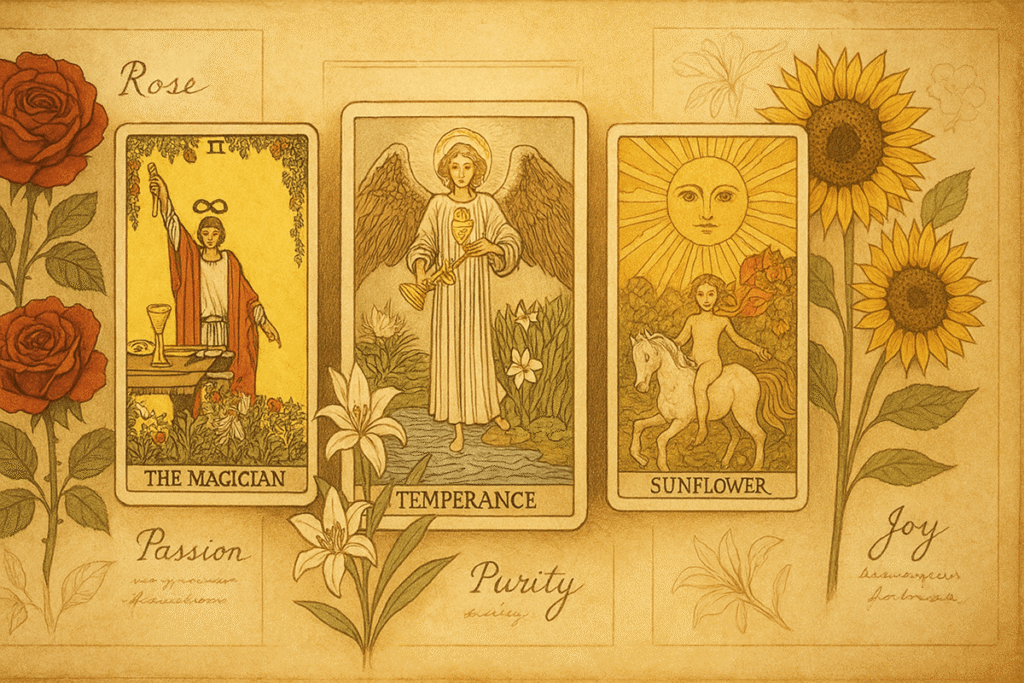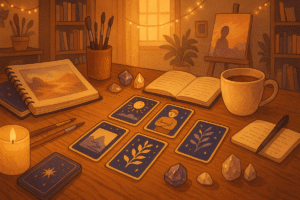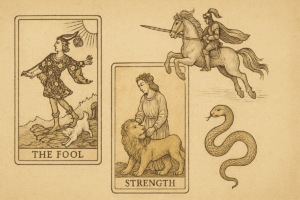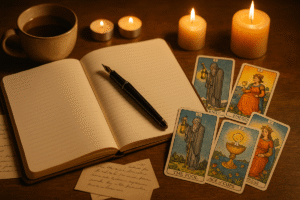Table of Contents
The Rider-Waite-Smith tarot deck, first published in 1909, remains one of the most visually rich and widely studied decks in existence. What strikes me most about this particular deck is how deliberate every visual element feels. Nothing appears by accident. The flowers scattered throughout the cards aren’t mere decoration. They’re carefully chosen symbols that invite us to pause and reflect on layers of meaning that might otherwise go unnoticed.
I think there’s something fascinating about how Pamela Colman Smith, the artist behind these images, drew from Victorian flower language and older symbolic traditions. She created a visual vocabulary that speaks across time. When we look at these floral elements today, we’re tapping into centuries of accumulated meaning. Perhaps that’s why they still resonate so strongly.
This guide explores the symbolic language of flowers in the Rider-Waite-Smith deck. We’ll examine specific blooms and consider what they might invite us to reflect upon in our own lives. The goal isn’t to provide definitive answers but to open doorways for personal contemplation.
The White Lilies of Temperance
The Temperance card shows an angel standing with one foot on land and one in water, pouring liquid between two cups. In the foreground, white lilies bloom with quiet elegance. These aren’t wild flowers. They’re cultivated, pristine, almost otherworldly in their purity.
White lilies carry a long association with purity and spiritual refinement in Western art history. Medieval and Renaissance painters frequently included them in Annunciation scenes, where the angel Gabriel appears to Mary. The flower became a visual shorthand for divine grace, innocence, and the sacred feminine. Smith would have known this tradition well.
On the Temperance card, the lilies might prompt us to ask ourselves about purity in our own lives. Not necessarily moral purity in some rigid sense, but perhaps clarity of intention. What parts of your life feel muddied or confused right now? Where might you benefit from a clearer, more distilled approach? The lilies don’t tell us we must be pure. They simply stand there, inviting reflection on what purity might mean to us personally.
I find it interesting that the lilies appear rooted in solid ground while the angel works with water. There’s something about that combination that feels important. The flowers represent something stable and constant, even as the figure above practices the fluid art of balance and mixture. Maybe that’s worth sitting with. What in your life provides that kind of grounding while you navigate change?
The number of petals, the way the stems stand straight, the fact that there are multiple blooms rather than just one. All these details might carry meaning, or they might simply be aesthetic choices. That ambiguity is part of what makes tarot such a rich contemplative tool.
Red Roses in The Magician’s Garden
The Magician stands before a table laden with tools, one hand pointing skyward and one toward earth. Behind him, a garden grows. And in that garden, red roses bloom abundantly. These aren’t subtle background details. The roses form a deliberate frame, a living border that demands attention.
Red roses have symbolized passionate love and desire for centuries, perhaps even millennia. In Roman mythology, they were associated with Venus. Medieval poets used them as metaphors for both earthly and divine love. By the Victorian era, the red rose had become the universal symbol of romantic passion. But I think there’s more happening here than simple romantic symbolism.
On The Magician card, the roses might represent the passionate will needed to manifest one’s intentions. The Magician is, after all, about taking abstract potential and making it real. That requires energy, drive, a kind of burning focus. The roses could be prompting us to consider our own relationship with desire and creative passion. What are you passionate about creating in your life right now? Where does your energy want to flow?
There’s also something worth noting about how roses grow. They’re beautiful, yes, but they have thorns. Beauty and pain intertwined on the same stem. Perhaps that’s part of the reflection here too. The passionate pursuit of our goals often involves discomfort or sacrifice. The roses don’t warn us away from passion. They simply remind us of its complete nature.
The fact that these roses appear in a garden rather than growing wild also feels significant. Gardens require tending, planning, ongoing care. They represent cultivation rather than pure spontaneity. Maybe the roses are asking us to think about how we cultivate our passions. Are we tending them properly? Have we let certain creative gardens become overgrown or neglected?
I sometimes wonder if Smith chose roses specifically to connect The Magician to a long tradition of alchemical and mystical imagery. Roses appear frequently in esoteric symbolism, particularly in Rosicrucian traditions. That layering of meaning upon meaning creates depth that rewards repeated contemplation.
Sunflowers Standing Tall on The Sun Card
The Sun card practically radiates joy. A child rides a white horse beneath an enormous sun, and behind them, four large sunflowers stand like guardians or witnesses. These aren’t delicate blooms. They’re bold, oversized, impossible to miss. They turn their faces toward the light.
Sunflowers carry perhaps the most straightforward symbolism of the flowers we’re examining. They represent joy, vitality, optimism, and the natural tendency to seek light. They’re heliotropic, meaning they follow the sun’s movement across the sky during their growing phase. That physical characteristic has made them powerful symbols of spiritual seeking and the soul’s orientation toward divine light or higher consciousness.
On The Sun card, these flowers might invite us to reflect on our own relationship with joy and positivity. Do you allow yourself to turn toward what brings you light? Or do you sometimes resist happiness, suspicious of it, unable to trust it? The sunflowers just stand there, doing what comes naturally to them. There’s something very simple and unpretentious about that.
The number four also carries meaning in tarot numerology, often representing stability, foundation, and earthly manifestation. Four sunflowers rather than three or five. Four corners of a solid base. Perhaps this suggests that true joy isn’t fleeting or unstable but can be grounded in something real and lasting.
I’ve noticed that sunflowers in art often appear during late summer and early autumn. They mark a particular moment in the seasonal cycle when things reach their fullest expression before beginning to decline. There’s something bittersweet about them if you think about it. They represent peak vitality, but also the awareness that nothing stays at peak forever. That complexity might be part of their placement on The Sun card too.
The sheer size of the sunflowers compared to the child on the horse creates an interesting visual relationship. The flowers tower above the human figure. Maybe that’s worth contemplating. Sometimes the simple gifts of nature, of light and growth and turning toward warmth, are actually greater than our human dramas and concerns. Sometimes joy is bigger than we are.
Flowers as Mirrors for Contemplation
Looking at these three examples together reveals something about how Smith used floral symbolism throughout the deck. Each flower invites a different quality of reflection. The white lilies ask about purity and clarity. The red roses question our relationship with passion and creative will. The sunflowers prompt consideration of joy and our natural orientation toward light.
None of these flowers tell us what to do. They don’t predict outcomes or prescribe actions. Instead, they function as visual prompts for deeper self-inquiry. What does purity mean in your life right now? How are you cultivating your passions? Are you allowing yourself to turn toward joy?
This approach to tarot treats the cards as psychological mirrors rather than fortune-telling devices. The flowers become entry points for meditation, journaling prompts, or simply moments of pause in our busy lives. When we encounter these images, we can choose to stop and ask ourselves the questions they seem to raise.
I think perhaps that’s the real gift of studying these symbolic elements. Not that we arrive at fixed meanings we can memorize and apply mechanically, but that we develop a practice of noticing, questioning, and reflecting. The flowers have meant different things to different people across centuries. What they mean to you, today, in this particular moment of your life, is valid and worth exploring.
Deepening Your Practice with Floral Awareness
If you’re interested in working more deeply with floral symbolism in your tarot practice, there are several approaches you might consider. One method is to keep a journal specifically focused on flowers. Each time you draw a card with flowers, write about what those particular blooms evoke for you personally. Your associations might differ from traditional meanings, and that’s perfectly fine. Personal resonance often provides the most meaningful insights.
You could also study the Victorian language of flowers, sometimes called floriography, which was a complex system of symbolic communication using different blooms. Many of Smith’s choices likely drew from this tradition. Understanding that context can add layers to your reflections without making the meanings rigid or prescriptive.
Another practice involves simply spending time with actual flowers. If you draw a card with roses, go observe real roses if possible. Notice how they grow, how they smell, how they change over their lifecycle. That direct sensory experience can inform your understanding of the symbolic rose in ways that pure intellectual study cannot match.
Some people find it helpful to create their own floral reference guide for the cards. This becomes a personal grimoire of sorts, collecting your evolving thoughts and observations about each flower as you encounter it over time. The meanings might shift as you change, and that evolution is part of the practice.
Final Reflections on Growth and Symbolism
Flowers grow slowly. They require the right conditions, proper care, and time. Perhaps that’s the most important symbolic message they carry across all the cards where they appear. The work of self-understanding, of personal development, of learning to reflect honestly on our lives unfolds gradually. We plant seeds of awareness and tend them patiently.
The Rider-Waite-Smith deck gives us these floral images as gifts. Not as answers, but as companions in the ongoing journey of self-discovery. The lilies, roses, and sunflowers have been speaking their symbolic language for over a century now, and they’ll continue speaking it long after we’re gone. What we hear in their silence depends entirely on how willing we are to stop, look closely, and ask ourselves honest questions.
Maybe start with one flower. Choose a card that calls to you and spend some real time with its floral elements. Let the questions arise naturally. See where they lead you. That’s the practice. That’s how these symbols come alive and become truly useful rather than just pretty pictures in an old deck of cards.
Frequently Asked Questions
Do other tarot decks use different flowers than the Rider-Waite-Smith?
Yes, many modern decks feature different floral choices or place flowers on different cards entirely. Some decks like the Spirit of Flowers Tarot assign a unique flower to every single card, while others might replace traditional imagery completely. The Rider-Waite-Smith established a foundation that many decks reference, but contemporary artists often bring their own botanical knowledge and cultural perspectives to their interpretations, creating fresh symbolic layers.
Why do roses and lilies appear together on several cards?
When roses and lilies appear together in the Rider-Waite-Smith deck, they create a symbolic message about balance. In Hermetic tradition, which influenced the deck, roses represent wisdom while lilies represent compassion. This pairing invites reflection on how different energies work together. Rather than seeing them as opposing forces, you might consider how wisdom and compassion, action and reflection, or outer work and inner development complement each other in your own life.
Can I use flower symbolism if I’m working with a non-RWS deck?
Absolutely, though you’ll want to pay attention to what flowers actually appear in your specific deck. Take time to notice which blooms the artist chose and where they placed them. Your deck’s guidebook might explain the artist’s intentions, or you could research the traditional meanings of those particular flowers. The reflective approach works with any floral imagery by asking yourself what feelings or associations arise when you see specific blooms in a reading.







